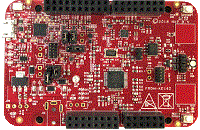FRDM-KE16Z

-
Core
Cortex-M0+
-
Device
MKE16Z64VLF4 -
CMSIS Pack
FRDM-KE16Z_BSP
-
pdb_adc12_trigger
Keil Studio AC6, GCC, IARThe pdb_adc12_trigger example shows how to use the PDB to generate a ADC trigger.Based on the basic counter, to use the ADC trigger, just to enable the ADC trigger's "milestone" and set the user-defined value for...See more details in readme document.
Download Pack -
pdb_adc12_trigger
µVision AC6The pdb_adc12_trigger example shows how to use the PDB to generate a ADC trigger.Based on the basic counter, to use the ADC trigger, just to enable the ADC trigger's "milestone" and set the user-defined value for...See more details in readme document.
Download Pack -
pdb_delay_interrupt
µVision AC6The pdb_delay_interrupt example show how to use the PDB as a general programmable interrupt timer.The PDB is triggered by software, and other external triggers are generated from PDB in this project,so that user can...See more details in readme document.
Download Pack -
pdb_delay_interrupt
Keil Studio AC6, GCC, IARThe pdb_delay_interrupt example show how to use the PDB as a general programmable interrupt timer.The PDB is triggered by software, and other external triggers are generated from PDB in this project,so that user can...See more details in readme document.
Download Pack -
pflash
Keil Studio AC6, GCC, IARThe pflash example shows how to use flash driver to operate program flash:
Download Pack -
pflash
µVision AC6The pflash example shows how to use flash driver to operate program flash:
Download Pack -
power_manager
µVision AC6The Power manager demo application demonstrates the use of power modes in the KSDK. The demo use the notification mechanismand prints the power mode menu through the debug console, where the user can set the MCU to a...See more details in readme document.
Download Pack -
power_manager
Keil Studio AC6, GCC, IARThe Power manager demo application demonstrates the use of power modes in the KSDK. The demo use the notification mechanismand prints the power mode menu through the debug console, where the user can set the MCU to a...See more details in readme document.
Download Pack -
power_mode_switch
Keil Studio AC6, GCC, IARThe Power mode switch demo application demonstrates the use of power modes in the KSDK. The demo prints the power mode menuthrough the debug console, where the user can set the MCU to a specific power mode. The user...See more details in readme document.
Download Pack -
power_mode_switch
µVision AC6The Power mode switch demo application demonstrates the use of power modes in the KSDK. The demo prints the power mode menuthrough the debug console, where the user can set the MCU to a specific power mode. The user...See more details in readme document.
Download Pack
